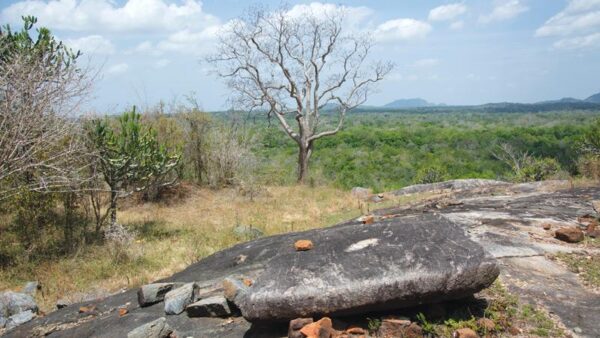Veheradiulana: paradise for treasure hunters-by Mahil Wijesinghe

The vandalised archaeological remains on the top of the rocky boulder
Source:Sundayobserver
The historically important archaeological site of the Veheradiulana ancient monastic complex is located upon a rocky ridge above the crust of Yala’s North-East edge. You can get to Veheradiulana from Kumbukkan Oya, which takes you past Kebilitta, on the verge of the virgin forest. It is around 30 kilometres from the South of the Kotiyagala, village in the drought-affected Moneragala district. We took this route to reach the site as it was an adventurous journey.
The archaeological remains of three crumbling dagabas, caves with drip-ledges and ruins of several other ancient structures have been ravaged by treasure hunters. Archaeologists believe that the bank of Kumbukkan Oya in the Yala Sanctuary had been a densely populated area in the past.
According to tradition, the Wattarama ancient Buddhist monastery in Kotiyagala, Talaguruvehera and Veheradiulana in zone III of Yala National Park and had been the abodes of thousands of meditative bhikkhus in ancient times, However, no one has yet carried out any excavations to establish its history.
Wasted natural rock pond
It took us almost seven hours to reach Veheradiulana. We were in for a discovery and had to walk around 300 metres from tractor track to reach the site which is a massive rock boulder where the monastery was built. The place was littered with ruins of different sizes in caves, while rock-hewn steps lead up to the remains of the crumbling dagabas and caves.
Halfway up the rock boulder, a fairly large natural rock pond, apparently used to collect water for the use of the bhikkhus, is now in the rendezvous of the denizens of the wild. It was full of slit, and had only three feet of water. If the Department of Wildlife cleans this often, it would be a good source of water for the animals during the drought. Our eyes were pleased with the site of a big wild boar resting peacefully in a marshy plot on the rock.
We were encompassed by the serenity and silence that prevailed at the site during our stay. The caves and ruins indicated that it must have been of some importance as a monastery in the past. A series of steps cut into the rock surface approached the top from all four sides of the rock boulder.
We were able to see slightly visible rock-hewn steps on one side with deep slope, which were fast decaying due to the antiquity of the place. Creeping through thorny bushes, we came across a drip-ledged cave at the site. Two ancient brick walls covered both sides of the cave which indicated that this had been a shelter for meditating bhikkhus or perhaps, a shrine room in the past. It houses a wooden figure in the actual size of a human, painted in yellow. We learned that it was the figure of a deity made by a man and brought here for keeping in this cave, due to the misfortunes experienced in his village.
Destroyed three stupas
It was vandalism of the worst kind on a rare and precious Buddhist heritage site on the rocky boulders scattered in the jungles of Yala, which a group of human vultures had destroyed mercilessly. Walking around the rocky summit of Veheradiulana, ‘Ratu ayya’, our guide, showed us three small dagabas which have disappeared, leaving in their place three deep holes. The bricks of the dagabas were scattered everywhere on the slope of the rock boulder. Obviously, nothing had been spared.
A few yards to the west of the rock boulder, we spotted another drip-ledged cave, believed to be the main shrine room housing a reclining Buddha.

No research done to preserve
We noticed that the entire interior of the cave was broken, dug and blasted beyond recognition. There was a very deep hole beneath the rock with water, as pieces of granite taken from the hole had been placed mouth of the cave. Here, it looked as if vandals might have used dynamite to blast the rock to search for treasure. Since no archaeological survey has been carried out at the site, we could not find any historical details about the Veheradiulana ancient site.
It was obvious that the place had been ancient Buddhist monastic complex for meditative Bhikkhus. Walking to the other side of the steep rock, we stumble upon many stone ruins strewn here and there. We saw a number of stone pillars at the site, buried in the earth, some leaning and some fallen on the ground.
On the eastern side of the rocky boulder of the Veheradiulana ancient site, the most outstanding feature was the beautiful chimney like rod-shaped rock which was tall and narrow and lies at the top of the rock.
It dominated the jungle landscape like a bit of Gothic architecture. From this point we glimpsed the verdant landscape of the lush green forest canopy of the Yala Sanctuary, virtually to infinity.
Today, the archaeological remains of Veheradiulana, such as, crumbling dagabas, caves and the ruins of several other ancient structures have been ravaged by treasure hunters and there is nothing left for conservation. The strange thing is, all this destruction has been done by those who call themselves Buddhists. At the summit of the rock, we saw granite rocks and bricks of ancient dagabas and structures which have been left to the mercy of the natural elements and the ravages of time.







